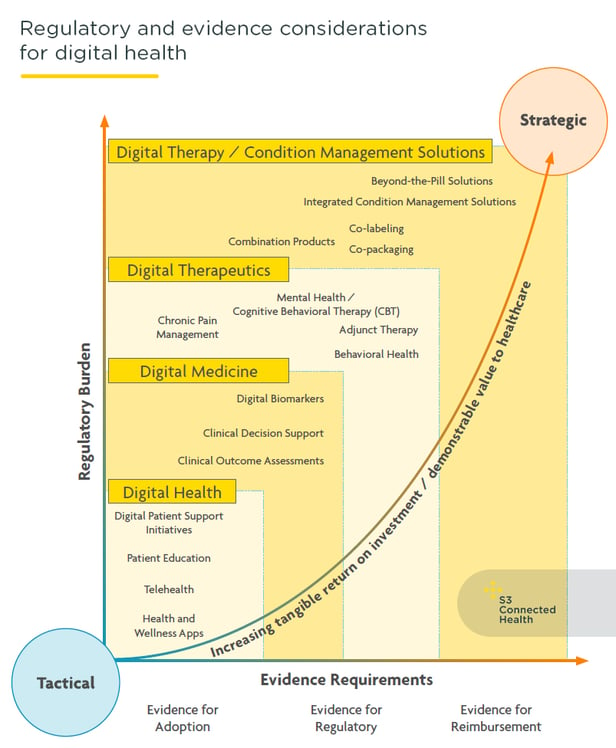Whether it’s teething problems in the past with systems like electronic health records, or confusion around the myriad of different tools that exist in hospitals today, when it comes to digital healthcare, complexity gets a bad rap.
While more complex digital health solutions, like digital therapeutics, require greater clinical evidence and regulatory oversight, they provide benefits far beyond tools usually perceived as ‘simpler’. The fact is that complex solutions have a greater impact on outcomes and provide more tangible benefits for patients, clinicians, and vendors alike; outweighing any potential increase in cost or time required to bring to market.
Aiming high and developing more complex solutions that have a greater impact on outcomes is a good thing. Here's why.
What we mean by complexity, and why it helps
Imagine the range of digital health solutions available in the market on an upwards sloping curve: you have simpler health and wellness apps on the bottom, followed by patient support initiatives, digital therapeutics, and condition management solutions right at the top.
The higher the sub-category on the graph, the greater the requirements on investment, time, evidence, regulatory matters, care pathway integration, and clinical review processes – but at the same time, you also see more tangible ROI. Why?
It’s not simply a case of more money in, more results out. Developing more complex solutions – by which we mean well-designed solutions that provide evidence and meet regulatory requirements – enables more holistic treatments of conditions and their side effects; offering more demonstrable value on healthcare outcomes.
Vertically-focused, stand-alone solutions often only address a small number of patient needs. But by combining a number of solutions to provide broader management of a condition, you create a more holistic service; better meeting the variation of needs that exist within a given patient population. This also makes healthcare provision far more convenient for clinicians, who benefit from greater choice when it comes to the approach or specific package of care they provide for each individual patient.
Someone with psoriasis, for example, may feel the impacts of the condition in many different aspects of their life. But while pharmaceuticals can treat the condition itself, they don’t address wider issues like the impact of the condition on mental health and quality of life. Adding mental health support and building better links with healthcare practitioners to address flare-ups could provide significant benefit.
How to ensure your digital health solutions are thorough
The key to creating a broad-reaching, multifaceted digital health solution is to eat the proverbial elephant piece by piece. Start with your objective or goal and, bit by bit, create a road map for your entire solution.
A methodical approach will help you find the ‘sweet spot’ that is right for your business. By outlining your objectives and goals, and the nature of the condition you’re looking to treat, you’ll naturally determine where you fall on the complexity curve.
That being said, don’t be afraid to branch into higher reaches of the digital health diagram below in your planning phase. When outlining your objectives and goals, move beyond minimum viable features and think about the maximum possible benefits you can provide to clinicians, patients, and vendors.
Outlining a Core Adoptable Solution and going through a rigorous solutions guidance process are cost-effective ways to examine your tool from every angle and add completeness into your solutions; preventing you from wasting investment on unnecessary, costly iterations. Partnering with a specialist digital health firm will give you access to the expertise needed here, while reducing the burden on internal teams and ensuring regulatory compliance.
Five tips to stay on track
- Prioritize efficiency. When expanding the scope of a digital health solution, it’s important to keep efficiency, not maximization, front-of-mind. Not every solution needs every possible bell and whistle, and any feature you include should directly meet the needs of patients, clinicians, and vendors. However, oversimplification is not the answer either. Engaging with all your stakeholders early on in the planning process and conducting a thorough investigation of the problem you’re looking to solve should help you get the right balance.
- Set realistic expectations. It’s important to be practical about what you can achieve; intricacy takes time. You won’t build a platform to break into the $3 billion digital therapeutics industry in a year, for example, but the ultimate payoff could be far more significant. It’s important to be clear on these expectations and have open conversations with your stakeholders, too, to make sure you’re on the same page.
- Manage your investment. Holistic solutions needn’t be extremely expensive, but you should be clear on budgets and price expectations. Building new solutions on top of existing digital health platforms saves you creating everything from the ground up; it’s a good way to get the most value out of your investment and bring your solution to market in a shorter time frame.
- Be aware of regulatory requirements. As a rule of thumb, the higher up on the digital health diagram you go, the more validated evidence you will need to substantiate your solution. Working with a trusted partner is a good way to deal with this extra regulatory responsibility if you’re less familiar with the processes.
- Seek support where needed. Most importantly, whatever solution you want to create, don’t let perceived complexity stand in your way. If you have any questions on how to create the right digital solution for you, don’t hesitate to get in touch.
Brian Flatley
Head of Consulting
S3 Connected Health
For more information on finding the path to market for your digital health solutions and how to navigate the associated regulatory challenges, download our latest whitepaper below:




